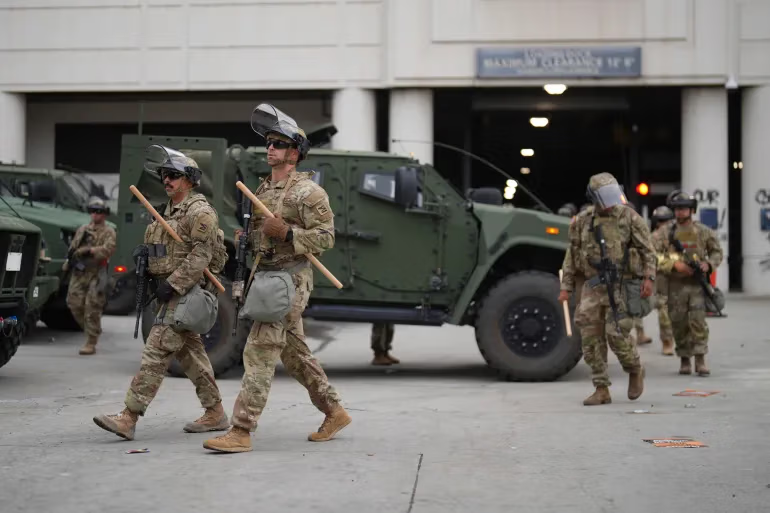United States President Donald Trump ordered the deployment of 2,000 National Guard troops to Los Angeles County in response to growing protests against coordinated immigration raids — bypassing the authority of California Governor Gavin Newsom.
The deployment, which came Saturday, marked the second day of protests in the area, following a series of federal immigration raids across Southern California. The decision has sparked political outrage and raised constitutional questions over federal authority and states’ rights.
Despite reports from the Los Angeles Police Department stating that Saturday’s demonstrations were peaceful and that “the day concluded without incident,” clashes broke out in nearby Compton and Paramount. Protesters and police faced off in the streets, with law enforcement using tear gas and flashbang grenades to disperse crowds.
Local officials, including Governor Newsom, said they did not request federal assistance. In a sharply worded statement, Newsom condemned the deployment as “purposefully inflammatory.”
“Not because there is a shortage of law enforcement, but because they want a spectacle,” Newsom said, accusing the Trump administration of stoking tensions.
How Did the Protests Begin?
The unrest began on Friday when law enforcement agents in full riot gear raided a Los Angeles building supply store, detaining day laborers in what was described by witnesses as a military-style operation. The arrests were reportedly made without judicial warrants — a claim backed by legal observers and the American Civil Liberties Union.
Federal authorities confirmed the scale of the operation. According to the Department of Homeland Security, more than 100 undocumented immigrants were arrested in two days of raids.
Word of the arrests quickly spread through neighborhoods in southern Los Angeles, prompting hundreds of residents to take to the streets in protest. Tensions escalated as local police responded with force.
Understanding the National Guard’s Role
The National Guard is composed of part-time soldiers who can serve at both the state and federal levels. Under normal conditions, a state’s governor can activate the Guard during emergencies — including natural disasters, public health crises, or civil unrest.
However, under certain legal conditions, the federal government has the authority to “federalize” the Guard, placing them under presidential command. This typically requires the invocation of the Insurrection Act, which empowers the president to deploy troops in cases of rebellion or civil disorder. Yet Trump did not formally invoke the Insurrection Act in this case.
Instead, the administration relied on a separate provision in the U.S. Code on Armed Services, which permits federal command of the National Guard when “there is a rebellion or danger of a rebellion against the authority” of the United States. However, the same statute states that such orders should be issued “through the governors” — raising legal concerns over the legitimacy of Trump’s unilateral action.
Trump justified the deployment by stating that “protests or acts of violence” obstructing the enforcement of federal laws would “constitute a form of rebellion” against the government.
Legal and Political Fallout
Legal experts warn that Trump’s decision to sidestep Governor Newsom may not withstand court scrutiny. Civil rights attorney Robert Patillo told Al Jazeera the order is likely to be challenged.
“Normally, federal troops are going to be used inside states at the invitation of the governor of that state,” Patillo explained, referencing the 1992 Los Angeles riots, when then-Governor Pete Wilson formally requested federal intervention.
“But if the governor, such as Gavin Newsom, has not asked for federal troops to come in, and these troops are coming in against his will, then there will be challenges … and this will have to go to the Supreme Court in order to determine who has a legal right to deploy those troops.”
This is not the first time Trump has turned to military solutions during domestic unrest. In 2020, amid nationwide protests following the killing of George Floyd by Minneapolis police, Trump threatened to invoke the Insurrection Act. Then-Defense Secretary Mark Esper resisted, stating that active-duty troops should be used “only in the most urgent and dire of situations.” In the end, Trump refrained from formal military deployment, instead asking governors to send their National Guard troops to Washington, DC.
However, Trump’s recent actions appear to reflect a change in approach. On the campaign trail in 2023, he openly expressed frustration with the limitations he faced during his first term.
“The next time, I’m not waiting,” Trump told supporters in Iowa, signaling his intent to bypass state authority in future domestic deployments.
As federal troops begin arriving in Los Angeles County, all eyes will be on the legal and political implications of a presidential directive issued over a governor’s objection — a clash that could reshape the balance of power between state and federal government in times of civil unrest.






